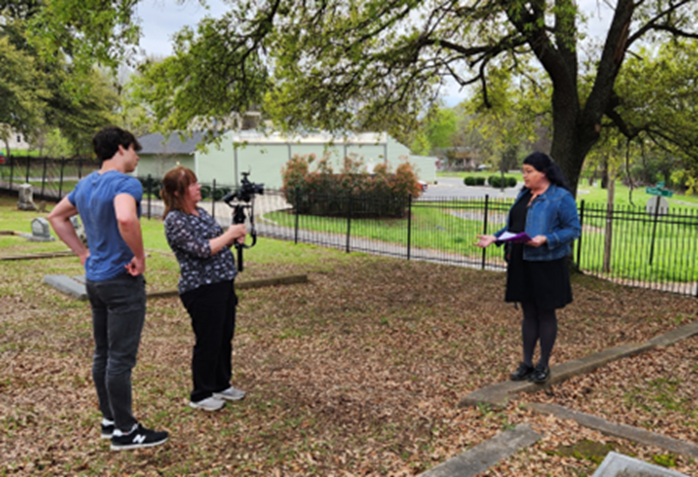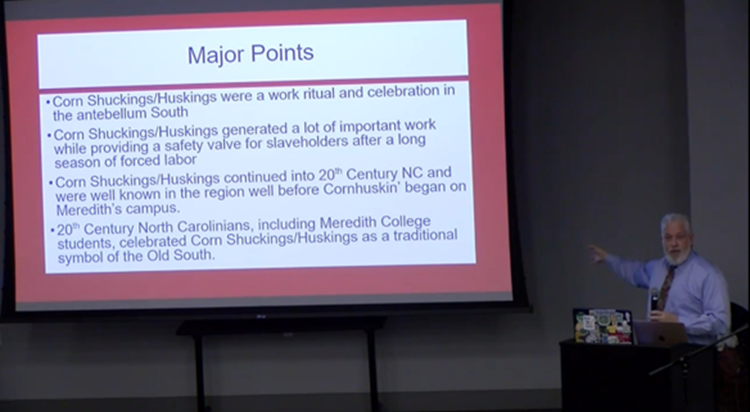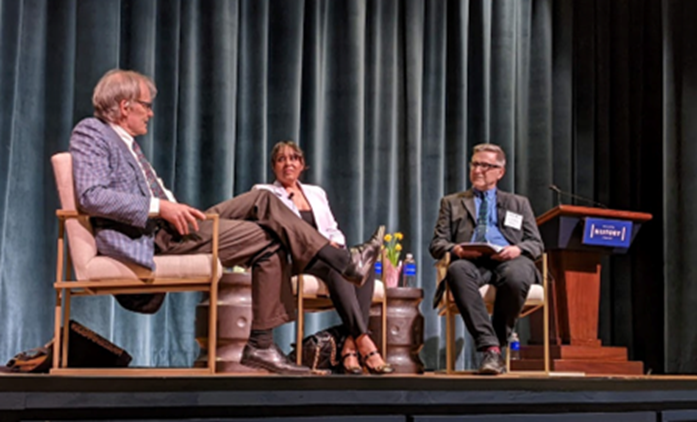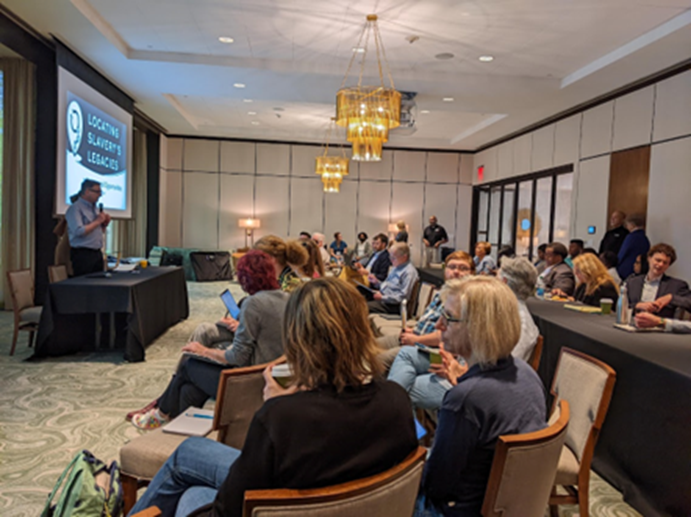In 2020, CIC selected seven member colleges as regional anchors for a national network to explore the Legacies of American Slavery. This multiyear initiative is supported by the Mellon Foundation and directed in collaboration with the Gilder Lehrman Center for the Study of Slavery, Resistance, and Abolition at Yale University. The goal is to help independent colleges and their communities reckon with the many afterlives of slavery in contemporary America through research, teaching, and public engagement. Here are just a few examples of projects undertaken by the regional partners during the 2022–2023 academic year. For more examples from many CIC member institutions, visit the Legacies website and subscribe to the blog at www.legaciesofslavery.net.
Austin College (Sherman, TX):
On April 27, Austin College hosted a student-organized and student-led conversation with two prominent local leaders: Fort Worth city council member Kathleen Hicks and her mother, former county judge Maryellen Hicks. The event grew out of a student research project inspired by a new course on “Race and Violence in Texoma,” developed as part of the Legacies initiative. The two women are descendants of William J. Durham, the influential civil rights activist and lawyer who argued the pivotal Supreme Court case of Sweatt v. Painter (1950), which desegregated the University of Texas law school. Durham lived just a few blocks from campus—and his law offices were destroyed in the 1930 Sherman Riot that devastated the city’s Black business district.
Centenary College of Louisiana (Shreveport, LA):
Students and faculty members at Centenary College are working with community partners—including Louisiana State University Health Shreveport—to explore the history of the region’s Black medical community and improve the training the future medical professionals. To highlight their research, they hosted a regional conference in November 2022 and created a local Medical History Tour. The tour, led by students and professors, highlights several key locations and provides details about the segregated medical system that arose after slavery and persisted for decades.
In 2022, students at Centenary also collaborated with a faculty mentor to bring more diversity to the biology lab experience by transforming existing anatomical models (which default to presenting White bodies). Student researcher Jazmine Carroll explains that “anatomical models can be very costly and there are very few nonwhite models available for purchase, [so] we decided to paint the models we already had.” The research team is now sharing with other colleges its expertise in selecting textures and shades of paint for better representation in anatomical models.

Huston-Tillotson University (Austin, TX):
The thematic focus at Huston-Tillotson University is race, health, and medicine, with particular attention to environmental justice in the region and health disparities by race in greater Austin. As part of the Community Engaged Research Program, student researchers are being trained to bridge gaps in healthcare access by supporting the work of two dozen local nonprofits. Faculty members are also developing new courses and field experiences to help students understand the connections between history (before and after slavery), geography, and environmental racism, including a summer program in partnership with The Descendants Project in Louisiana. Huston-Tillotson University celebrated Earth Day in April by hosting the Earth Day ATX festival. On display was a newly completed mural by local artist Candy Kuo, “Harvesting Hope,” which highlights the efforts of artists and activists to promote environmental justice across the nation.

Lewis University (Romeoville, IL):
One focus of the Legacies of Slavery work at Lewis University is mass incarceration, embracing both the history and the current realities of America’s prison system. This includes a new collaboration with Imagine Justice, a social justice advocacy group founded by the musician Common. The Rebirth of Sound project provides a state-of-the-art recording studio, musical instruments, and songwriting and production training to incarcerated men at the Stateville Correctional Center, which is located just a few miles from campus. The Lewis team is led by Huma Zia, assistant professor and program director for Paralegal Studies, Justice, Law, and Public Safety Studies, and Tennille Allen, professor of sociology and program director of the African American Studies and Ethnic and Cultural Studies programs. They are working with project director Antony Ablan, Chicago-based photographer Mateo Zapata, and a cohort of incarcerated men on a multimedia project that will explore the men’s participation in the Rebirth of Sound program, the communities they come from, their experiences and perceptions of incarceration, and their hopes and visions for the future.
Meredith College (Raleigh, NC):
This spring Meredith College wrapped up a successful year of public programming related to the legacy of slavery theme of “contested citizenship.” Some of the programs were outward facing, including the annual Voices of Change institute designed to support the political participation of Black women and women of color in North Carolina and beyond. Some of the programs focused more closely on the college itself, including a series of four public presentations that shared the research findings of students, faculty and staff concerning the history of slavery and race at Meredith. The “De-Lux Brunch” series was a collaboration between the Black Student Union, the Common Experience Committee of the School of Arts & Humanities, and the Universities Studying Slavery research team. The interest generated by these events played a significant role in encouraging the Board of Trustees to remove the name of Delia Dixon Carroll—a staunch white supremacist physician and eugenicist—from the campus health center in March.

Sewanee: The University of the South (Sewanee, TN):
Sewanee’s work on the theme of slavery and commemoration was book-ended by two teaching workshops this spring semester. On January 19–21, the university’s Roberson Project on Slavery, Race, and Reconciliation hosted “Except as Punishment: A Colloquium and Teaching Workshop Exploring Unfree Labor in the Post-Civil War South, 1865 to Present,” which attracted more than 40 faculty members, community activists, and public policy advocates from across the region. On April 6–7, the Roberson Project hosted “Monumental Opportunities: A Teach-In Event Introducing the Locating Slavery’s Legacies Database” at the Atlanta History Center. This was the formal launch of the Locating Slavery’s Legacies database (LSLdb for short), a digital humanities project and online repository designed to help faculty members, archivists, and students investigate and share information about memorials on their respective campuses—in particular, memorials that were built to support (or occasionally refute) the Confederacy and the “Lost Cause.”
The gathering in Atlanta brought together partners from a pilot phase of the project and prospective partners for an expansion of the database. The program opened with a public conversation about historical memory between prize-winning poet Natasha Trethewey and Yale historian David Blight. The next morning, participants rolled up their sleeves to review the pilot efforts and consider the challenges and opportunities for student research and learning offered by the LSLdb. The workshop was facilitated by Katie Burnett, associate professor of English at Fisk University. Representatives from more than a dozen CIC institutions participated in the workshop, including LSLdb pilot members Meredith College and Furman University.




